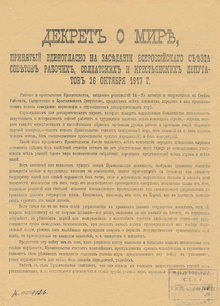Decree on Peace
The decree on peace ( Russian Декрет о мире / Dekret o mire ) in the First World War was the first decree of the new workers and peasants' government , which was replaced by the October Revolution of 24./25. October was created. It was drawn up by Vladimir Ilyich Lenin and was announced at the session of the All-Russian Council of Workers, Soldiers and Peasants' Deputies on October 26th . / November 8, 1917 greg. Unanimously adopted and published on the same day in the Izvestia newspaper (October 25th corresponds to November 7th, 1917 according to today's calendar ).
The decree led to peace negotiations between Russia and Germany and made the Brest-Litovsk peace treaty possible in 1918.
This decree, along with the decree on land and the decree on the rights of the peoples of Russia , is one of the so-called three subversion decrees , with the help of which the new Bolshevik leadership of Russia wanted to gain broad popular support as quickly as possible.
The decree contained demands for the immediate start of peace negotiations with all warring countries and condemned secret international agreements and treaties. Lenin described his idea of the new proletarian internationalism, which provided equal rights for all peoples and respect for independence from all peoples and governments. As an immediate measure, the decree proposed a ceasefire for three months.
The decree sparked enthusiasm among the war-weary Russian population. However, the decree was also born out of necessity, since the military situation for Russia was catastrophic and there was hardly any thought of further effective resistance to an advance of German troops in the west of the former tsarist empire . In other warring countries such as In the USA , France and Great Britain , for example , the decree sparked demonstrations against the war and in support of Soviet Russia . On October 27th, Jul. / November 9, 1917 greg. Lenin called on the radio to the Russian sailors and soldiers to an armistice. Ideologically, Lenin was able to distinguish himself as a peace politician and put the politicians of other war participants under pressure. The later 14-point program of US President Woodrow Wilson can also be understood as a reaction to Lenin's decree. The German side, on the other hand, was unimpressed by this pacifist attitude; Although the increasing weariness of war had an effect here too , the military leadership saw in Lenin's policy a welcome opportunity to consistently use Russia's weakened position to their own advantage.
While Trotsky , in particular , dragged out the negotiations with Germany in order to be able to propagandistically emphasize his own peace policy, the Germans continued their advance almost unhindered until their troops brought the entire Ukraine under their control. The Russian revolutionary government was therefore forced in March 1918 to agree to a dictated peace in Brest-Litovsk . But since " white ", i. H. Tsarist and counter-revolutionary forces had declared war on the Bolsheviks and took up arms and soon afterwards the Western Entente intervened in their favor, the government of Lenin had practically no opportunity to implement the principles formulated in the Decree on Peace together with the opposing party to implement.
This decree is considered to be the first ever document drawn up by a state body which condemns war as a means of resolving conflicts .
